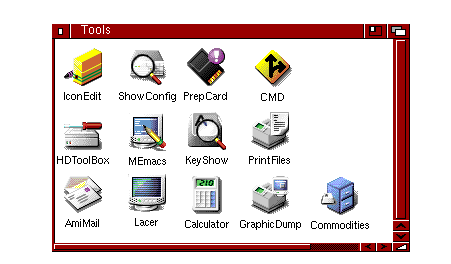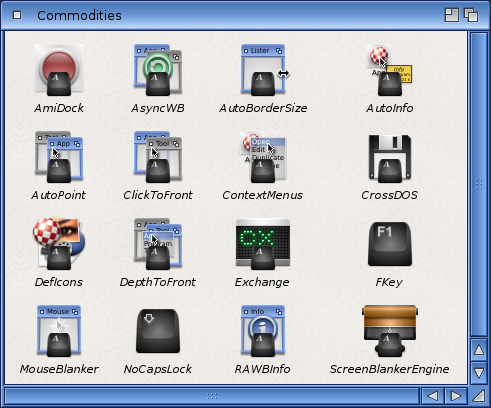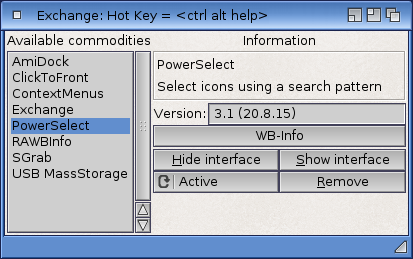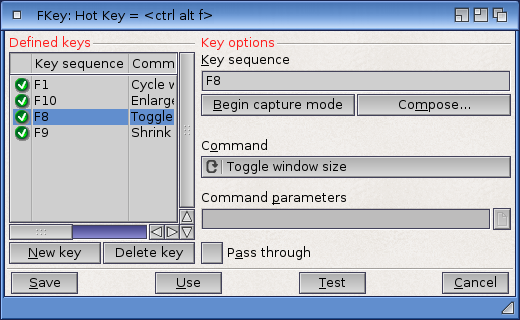Copyright (c) Hyperion Entertainment and contributors.
AmigaOS Manual: Workbench Other Programs
This chapter describes the programs found in the Tools and Utilities drawers.
Contents
Tools Drawer
The Tools drawer window, illustrated in Figure 10-1, contains numerous utility programs that, for example, expand your printing options, prepare memory cards for use, define new keys, and create new icons.
The following programs are found in the Utilities drawer:
| GraphicDump | Allows you to print screen images. |
| Installation Utility | Executes installation scripts. |
| Lacer | Turns video interlace on and off. (Classic Only) |
| Multiview | Multiformat file viewer. |
| Notepad | Text editor. |
| PartitionWizard | Allows you to check, repair, salvage, and optimize partitions. |
| PrefsObjectsEditor | Allows you to create and edit XML formatted preferences files. |
| PrepCard | Prepares PCMCIA memory cards for use on systems with a PCMCIA slot. (Classic Only) |
| PrintFiles | Sends files to the printer. |
| RawDisk | Allows you to read and write raw disk blocks. |
| UnArc | Unpacks archives. |
| USBInspector | Displays information on USB devices. |
| Commodities | A drawer containing programs that monitor your keyboard and mouse input. |
HDBackup and HDToolbox are also included in the Tools drawer on hard disk systems only. For information on these programs, see the Amiga Hard Drive User's Guide .
Lacer (Classic Only)
The Lacer program only works when a genlock device is attached to your Amiga. It toggles the display between interlaced and non-interlaced mode. This is used primarily for video recording and genlocking by allowing the Amiga to provide the interlaced input required by video devices.
PrepCard (Classic Only)
The PrepCard utility is used for preparing PCMCIA credit card-size memory cards. It runs only on Amiga models equipped with a PCMCIA card slot. PCMCIA is the organization that sets the standards for memory card slot devices.
PrepCard prepares static RAM cards either as a disk device or as system RAM according to PCMCIA standards. A card prepared as a disk can be used like a floppy disk: you can read from and write to the card just as you normally do from applications, the Workbench, or the Shell. Because the card's memory is battery-backed, the contents of the card remain when you remove the card or turn off the Amiga. Read and write operations using memory cards are very fast.
When prepared as system RAM, the card memory is added to the other memory in the Amiga, as if additional memory were installed internally. Cards are available in many sizes: from 64 KB to over a megabyte.
Open the PrepCard window by double-clicking its icon. If a card is inserted, its size and other information are displayed. The message FAILED in the Battery display box indicates that the card's battery has run down and must be replaced before the card can be used.
You can use PrepCard to prepare cards that are new (unformatted) or that have been previously prepared as disk or RAM.
- Select the appropriate gadget, either Prepare as DISK or Prepare as System RAM. A warning requester appears, reminding you that any information currently on the card will be erased if you continue.
- Select Continue to prepare the card or Cancel to return to the PrepCard window. Preparation takes only a few seconds.
- Select Quit to exit when you are finished with PrepCard. An icon for a card you have prepared as a disk immediately appears, labeled Empty.
| Note |
|---|
| Preparation does not continue if the card is write-protected. You can flip the write-protect switch to make it write-enabled without removing the card from the card slot. |
You can work with the card disk as a normal disk, rename it, and reformat it with the Workbench Format program. A card disk is device CC0:
To use the memory on a card prepared as system RAM, you must reboot. (The card must be write-enabled and inserted when you boot or reboot for its memory to be added to the Amiga's RAM.) Card memory is added to Fast (other) memory.
PrepCard has an Advanced Settings window listed on the menu. This window allows a variety of low level card configuration parameters to be altered from the default settings for diagnostic purposes.
| Note |
|---|
| Only those with sufficient technical knowledge should change the default settings in the Advanced Settings window. Improper settings do not harm the card or the Amiga, but it can keep the card from functioning properly. |
When using PCMCIA cards, note the following:
- PrepCard does not run if a card is currently in use as RAM. To run PrepCard again on a card prepared as RAM, insert the card after booting.
- Removing a card that is currently in use as RAM immediately reboots the Amiga.
- Do not write-protect a card while it is in use as RAM; this causes the Amiga to lock up, requiring you to reboot.
- The PCMCIA card slot is disabled when Fast RAM is configured to more than 4MB.
Commodities Drawer
The Commodities drawer, illustrated in Figure 10-6, is in the Tools drawer and contains the Commodities Exchange programs. These programs monitor your keyboard and mouse input to the Amiga.
| AutoPoint | Automatically activates the window under the pointer. |
| Blanker | Causes the screen to go blank if there has been no keyboard or mouse activity for a specified period of time. |
| ClickToFront | Lets you bring a window to the front of the screen by double-clicking in it. |
| CrossDOS | Controls text options for CrossDOS drives. See Chapter 11 for more information. |
| Exchange | Monitors and controls all the other Commodities programs. |
| FKey | Assigns special functions to keys. |
| MouseBlanker | Causes the mouse pointer to go blank when you are typing. |
| NoCapsLock | Temporarily disables the Caps Lock key. |
Using Commodities Tool Types
All of the Commodities programs share a common Tool Type:
- CX_PRIORITY=<n>
- Assigns priorities to the Commodities Exchange programs.
All the programs are set to a default priority of 0. If you enter a Tool Type that changes the priority to a higher value, that program has priority over any other Commodities Exchange program of lower priority.
For example, you can have two commodities that allow you to assign operations to functions keys. If both programs have an operation assigned to F1, the program with the higher priority intercepts the key, making it unavailable to any other Commodities programs.
There are two Tool Types that apply only to programs that open a window:
- CX_POPUP
- When set to NO, prevents the program window from opening when the icon is opened. The program activates when you double-click on its icon, but its window remains closed. The default is CX_POPUP=YES.
- CX_POPKEY
- Determines the hot key for a commodity. When the hot key or key combination is pressed, the program's window is automatically brought to the front of the screen. If the window is hidden, it is opened. Hot keys do not start commodities that are not already running. The syntax for specifying hot keys is CX_POPUP=<key>.
When specifying key combinations, leave a space between the two keys. For example:
CX_POPKEY=F9 CX_POPKEY=Shift F4 CX_POPKEY=LShift LAlt LAmiga X
Acceptable Key Combinations
When specifying key combinations for a Commodities Exchange program, you can use any of the function keys (F1 through F10) and any of the keys in the typewriter area of the keyboard (numbers, letter, symbols, and so forth). Keys from the typewriter area must be preceded by a qualifier. The allowable qualifiers are:
| Qualifier | Key |
|---|---|
| Alt | Either Alt key |
| Ralt | Right Alt only |
| LAlt | Left Alt only |
| Shift | Either Shift key |
| Rshift | Right Shift only |
| LShift | Left Shift only |
| LAmiga | Left Amiga |
| RAmiga | Right Amiga |
| CTRL | Ctrl |
| Numericpad | Specifies a key on the numeric keypad |
| Rightbutton | Hold down the menu button |
| Leftbutton | Hold down the selection button |
| Middlebutton | Hold down the middle button of a three-button mouse |
Qualifiers can also be used before function keys, but are not mandatory. You can use any combination of qualifiers; however, they must be followed by a standard key or function key. A qualifier is only recognized once in a combination:
LAlt RAmiga LAlt F10
is the same as
LAlt RAmiga F10
The following are acceptable combinations:
Alt F6 LAmiga 8 Ctrl LShift Y Leftbutton Ctrl CapsLock* Numericpad 8**
* Hold down the selection button, then press Ctrl+Caps Lock
** Use the 8 in the numeric keypad. The 8 in the normal area does not satisfy the combination.
AutoPoint
AutoPoint lets you select windows without clocking the selection button. To start AutoPoint, double-click on ist icon. AutoPoint does not open a window.
AutoPoint automatically activates the window that is underneath the pointer, eliminating the need to click the selection button.
To disable AutoPoint, double-click on its icon a second time or open the Exchange window, select AutoPoint from the scroll gadget, and the select the Remove gadget.
Blanker
When the Blanker program is running, the screen automatically goes blank if no input has been received during a specified period of time.
The Blanker window allows you to specify the amount of time (in seconds) before the screen goes blank. The default time is 60 seconds. If you do not press a key or move the mouse during a 60 second period, the screen goes blank. To change this value, enter an alternative in the text gadget after Seconds.
Blanker can also cycle through a series of colors if you check the Cycle Colors gadget box. Checking the Animation gadget displays a random spline display.
To disable Blanker, open the Exchange window, then select Blanker, select Remove, or pick the Quit item from the Blanker window's Project menu. The hot key for Blanker is Ctrl+Alt+B.
Tool Types
Blanker has the following Tool Types:
| SECONDS=60 | The number of seconds of keyboard/mouse activity before the screen is blanked. Default is 60. |
| ANIMATION=YES | Whether Blanker screen displays animation. Default is yes. |
| CYCLECOLORS=YES | Whether colors on the blanker screen are cycled. Default is yes. |
ClickToFront
ClickToFront lets you bring a window to the front of the screen without selecting the window's depth gadget. To bring a window to the front with ClickToFront, hold down left Alt and double-click anywhere in the window. (The use of left Alt can be changed with Tool Types.)
To start ClickToFront, double-click on its icon. ClickToFront does not open a window.
To disable ClickToFront, open the Exchange window, select ClickToFront from the scroll gadget, then select Remove or double-click on its icon again.
Tool Types
ClickToFront supports a QUALIFIER Tool Type, allowing you to specify a qualifier key that must be pressed while double-clicking in the window you want to bring to the front of the screen. The four acceptable key arguments are:
| Lalt | Left Alt (Default) |
| Left_Alt | Left Alt |
| Ralt | Right Alt |
| Right_Alt | Right Alt |
| CTRL | Ctrl |
| CONTROL | Ctrl |
| None | No qualifier necessary |
For example, if you have specified QUALIFIER=CTRL and ClickToFront is activated, hold down Crtl and double-click in the window you want frontmost.
CrossDOS
The CrossDOS commodity controls text options for active CrossDOS drives. The CrossDOS commodity window shows the available drives and allows you to set Text Filtering or Text Translation separately for each Hot key: Ctrl+Alt+C. For more information on the CrossDOS commodity, see Chapter 11.
Exchange
Exchange manages the background utilities contained in the Commodities drawer. The hot key for Exchange is Ctrl+Alt+Help.
The Exchange window, illustrated in Figure 10-7, lists the commodities that are running and displays information about each one as it is selected.
| Remove | Turns off commodities. |
| Show Interface | Displays the commodity window, allowing you to interact with it as if you pressed the commodity's hot key. |
| Hide Interface | Closes the commodity window without turning the commodity off. |
FKey
FKey allows you to assign functions to keys, eliminating the need for repetitive typing.
When you double-click on the FKey icon, the window illustrated in Figure 10-8 appears:
FKey lets you assign any of eight commands to any key sequence that you can enter.
The Defined Keys scrolling list shows all the currently defined key sequences.
The New Key and Delete Key gadgets let you add and remove key sequences.
The Command cycle gadget lets you pick a command for the current key sequence. The possible commands are:
| Cycle Windows | Brings the rearmost application window on the Workbench screen to the front of the display and selects it. |
| Cycle Screens | Brings the rearmost screen to the front of the display. |
| Enlarge Window | Enlarges the selected window to its maximum size, taking into account the edges of the screen. |
| Shrink Window | Shrinks the selected window to its minimum size. |
| Toggle Window Size | Zooms the selected window as if you had selected its zoom gadget. It also works on windows that only have a zoom gadget and no sizing gadgets. |
| Insert Text | When the key sequence is entered, the specified string is inserted in a console window or text gadget. It has no effect if something that accepts keyboard input is not selected. The string to insert is specified in the Command Parameters gadget. |
| Run Program | Lets you run a program by entering any key sequence. The program name and its arguments are specified in the Command Parameters gadget. |
| Run ARexx Script | Lets you run an ARexx script by entering any key sequence. The script name and its arguments are specified in the Command Parameters gadget. Putting quotes around the script name turns it into an ARexx string file. |
The Command Parameters text gadget lets you specify arguments for three of the commands.
For example, to designate Alt F1 as the key sequence to start MultiView, follow these steps:
- Select the New Key gadget.
- Enter the key sequence in the string gadget as Alt F1 (be sure to enter a space between Alt and F1).
- Select the Run Program option in the Command cycle gadget.
- Enter the path for MultiView (SYS:Utilities/MultiView) in the Command Parameters text gadget.
MouseBlanker
MouseBlanker blanks the mouse pointer from the display when you are typing at the keyboard. The mouse pointer returns to the screen when you move the mouse again.
To enable MouseBlanker, double-click on its icon. To disable MouseBlanker, double-click on its icon again or open the Exchange window, select MouseBlanker from the scroll gadget, and select the Remove gadget.
NoCapsLock
NoCapsLock disables the Caps Lock key. The Shift keys still function normally, but Chaps Lock has no effect if pressed accidentally.
To start NoCapsLock, double-click on its icon. It does not open a window. To disable NoCapsLock, open the Exchange window, select NoCapsLock from the scroll gadget, and select the Remove gadget or double-click on its icon again.



